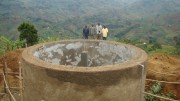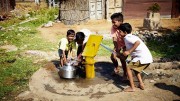A smouldering controversy over the resettlement of villagers in South Africa to make way for the expansion of an Anglo Platinum (AMS-J, AGPPF-O) mine underscores the importance of getting relocation exercises right the first time around.
Anglo Platinum has come under fire from international anti-poverty agency ActionAid over the relocation of villagers near its Potgeitersrus mine near Limpopo in the northern limb of the Bushveld complex of South Africa.
In a 57-page report released in March, the NGO alleges villagers in the area were removed from their homes in relocation agreements signed with associations that Anglo Platinum had claimed represented the community, but which ActionAid believes were set up by the company itself.
The NGO contends that villagers were “generally offered little compensation” and “insufficient ways of making an alternative living,” and asserts that thousands of people have lost agricultural land and access to clean drinking water.
Anglo Platinum denies the allegations. It says families were not forced off their land and that 98% of the 7,000 residents of Ga-Pila village moved willingly. The company also dismisses claims that it did not consult villagers, arguing it held “intensive consultation” over a ten-year period. “All households were party to the contents of the agreement and signed these off willingly and without coercion of any sort,” Anglo Platinum contests.
The company argues that the relocation resulted in better housing, additional financial payments, better village infrastructure, improved schools and clinics, a range of economic opportunities, as well as more and better land. And it rebuts claims that contaminated water is the result of mining activities.
Wherever the truth lies, the world’s largest platinum producer is trying to douse the flames of its latest public relations disaster.Anglo Platinum did not respond to repeated requests for comment.
The resettlement controversy demonstrates yet again the importance for mining companies of adding proper and in-depth social components to their project feasibility studies. Today more and more mining companies are talking about improving how they deal with social issues during the exploration stage.
“Do it early so you have the lead-time to do it properly,” cautions Mike Steyn, a principal of rePlan, a Toronto-based firm of 70 planners, architects, engineers, social scientists and community development workers. “Start doing this at the pre-feasibility stageor do it even earlier. If you get it right you save so much time down the line.”
Steyn, a former resettlement manager and legal counsel to Gold Fields (GFI-N, GOFD-L) who grew up on the Zambian copper belt, knows of what he speaks. His first experience with resettlement was when he advised Gold Fields on a resettlement project in Ghana at its Tarkwa mine, which involved the relocation of 20,000 villagers from 14 different communities.
It was on that project that he met John van Nostrand, now his partner and the founder of rePlan. “The mining company was intent on doing the right thing but had no grasp of what was involved,” van Nostrand recalls of his first project for Gold Fields in 1994, which is now the biggest open-cast mine in Africa.
“It wasn’t easy for a South African mining company to wade into the countryside of Ghana and start talking to people,” van Nostrand says. “When they asked us if we could helpour first reaction was no way. Mining? We can’t get involved in that, we’ll be ruined.”
“The president at the time said, ‘Okay, but how do we know you won’t side with those people against us?’ and I said, ‘Well you don’t, but how do I know you’re not going to shoot one?’ And he said, ‘Well we’re not, but you don’t.'”
Initially Gold Fields thought the work would involve 2,000 to 3,000 people and estimated that it would take about three months to complete. But there were actually 20,000 people living there, 6,000 of whom were artisanal miners, and they lived in “serious” villages, van Nostrand says. “Could we sort it out in three months? Impossible.”
Ultimately it took van Nostrand and Steyn 18 months and more than 100 meetings with community members at Tarkwa before the massive undertaking could take place.
“Every single thing had to be negotiated, from where do we meet to how do we negotiate to what will the houses look like,” van Nostrand says. “We picked as a chair the only FIFA referee in Ghana, who also happened to be a miner. He used yellow and red cards.”
The entire project took five years from start to finish and involved building a new resettlement town with housing, basic services, and public facilities, over an area of about 35 hectares. A total of 468 houses were built and handed over to some 700 families.
“It was a model of community participation,” adds Steyn. “Even today I think there are many projects that don’t have that level of negotiations. I mean they talk to the people, but do they actually plan and negotiate together? That was the foundation of our success. These people were part of the planning, it wasn’t imposed on them.”
Negotiations centered around three different communities. The Akontansi community were interested in monetary compensation for relocation because most of the residents were not indigenous to the Tarkwa area and preferred to return to their hometowns instead.
A second set of negotiations involved the Apinto farmers, who were predominantly interested in crop compensation and negotiations centered on crop rates.
The third set of negotiations involved the Atuabo community, largely people who were resettling to a new community. This process included agreeing on the new settlement site, the housing package, infrastructure and community facilities.
“A tack that many mining companies take is that they’ll make decisions for them,” van Nostrand muses. “Well it’s a killer. Unless they really like it by fluke, and I’ve never seen that happen, it’s just fraught with problems.”
rePlan’s approach focused on compensation and resettlement, and a big portion of their efforts involved maintaining social, cultural and economic networks and activities to ensure a solid base for community growth.
One of the ways in which rePlan tried to look out for the community’s best interests was to hire as many local contractors as it could. At first Gold Fields wanted to bring in a big contractor from South Africa.
But rePlan convinced the company to see if it could find local contractors to do the job. Ultimately they were successful in hiring six local housing contractors who put in a bid that was half the amount that the South African contractor had bid for the project. The local builders won the contract and 70-80% of the funds remained in the local community in terms of wages, services, and the purchase of local materials.
“That amount is bigger than any World Bank grant would have been,” van Nostrand says happily. “To this day in Ghana, there are a couple of contractors that we used on Tarkwa that are now building mine accommodation for foreign companies and they are competing with foreign companies and can undercut them on price. It’s tremendous to see.”
For those planning not to resettle, Gold Fields asked the local bank manager to organize workshops for relocatees to offer financial advice on how best to manage their relocation money.
People were encouraged to open bank accounts and given advice on how best to manage their funds on issues such as whether to buy treasury bills or government bonds. Gold Fields also added various moving allowances to cover transportation and subsistence related costs during their relocation process.
One component was creating a small business loan fund to help groups of resettlers who were interested in starting a new business. The small business loan fund was complemented by a training program offered to support loan recipients.
A great deal of thought was also given to the design of the new houses. Most of the resettlers were eligible for a 1-, 2-, or 3-bedroom house, but additional space was made available for residen
ts to expand their houses, start small gardens or re-engage in commercial activities by creating residential plots of at least 250 sq metres. Resettlers were also offered a US$250 ex-gratia payment.
“It’s human geology,” explains van Nostrand. “You have your geology but it’s equally important to know the people’s situation there as intimately as you know the rock underneath and it will save you so much time.”
rePlan has since worked on more than ten resettlement projects and has had projects in Africa, South America, Eastern Europe and across North America. It has recently opened an office in the booming town of Fort McMurray.
But van Nostrand has a soft spot for Africa. In 1972, he turned down a scholarship to do a PhD at Berkeley to move to Botswana for two and a half years with his wife and three young children to work on a squatter resettlement project for the Canadian International Development Agency.
From there he worked on a number of other housing and planning projects across Africa for clients such as the World Bank in South Africa, Lesotho, Tanzania, and Uganda, before working for his first mining client with Gold Fields in 1994.
Since its first job for a mining company, the Toronto-based architectural firm has expanded its clientele to other mining heavyweights including Rio Tinto(RTP-N, RIO-L), Newmont Mining (NMC-T, NEM-N) and Barrick Gold (ABX-T, ABX-N), as well as a number of junior companies.
The Canadian firm has prepared baseline studies and preliminary planning for the resettlement of more than 11,000 people in Burkina Faso for Gold Fields and Orezone Resources (OZN-T) and worked on Newmont Mining’s Akyem and Ahafo gold mine resettlement projects in Ghana, as well as on Barrick’s North Mara and Bulyanhulu mines in Tanzania.
It has also worked on a series of action plans to mitigate the socio-economic impact of privatizing Zambia’s copper mines.
Of course rePlan has to be selective about the projects it chooses. After two years preparing a resettlement action plan for a major project in Eastern Europe, it formally withdrew from the assignment. In rePlan’s view, the company was not following recommended IFC procedures or negotiating fairly with affected households.
In fact rePlan has had to withdraw from a total of three projects because it experienced considerable difficulty with mining companies “who relied on local personnel who had little respect for the affected households,” van Nostrand says.
Sums up Steyn: “It’s important to raise the bar because if there’s one bad mine, then everyone tends to be painted with the same brush. It’s not about being nice to people, it’s the right thing to do and there’s a business case for it.”



Be the first to comment on "Relocations aren’t easy, so get them right the first time around"